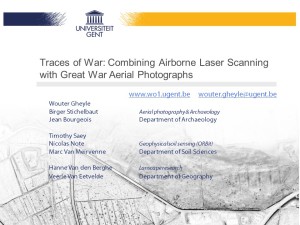Traces of War: Combining Airborne Laser Scanning with Great War Aerial Photographs
In spite of an increase in World War I-related excavations in Flanders (Belgium), little is known about the exact nature and extent of the buried heritage of WWI from research on a landscape scale. The research project ‘Non-Invasive Landscape Archaeology of the Great War’ (see poster session) combines archaeological research, analysis of historical WW I aerial photographs, multireceiver EMI soil sensing and landscape analysis to acquire a concrete understanding of the archaeological preservation of WW I heritage along the Western Front in Belgium.
Historical aerial photographs are an excellent source to study the war landscape. All the more if the results are combined with archaeological field surveys or ALS data in search for above ground remains and non-invasive geophysical research that gives an idea of the archaeological preservation under the plough soil.
This contribution examines the possibilities of the newly available Airborne Laser Scanning (ALS) dataset for Flanders, with an average point density of 16 points per m² (DTM-Flanders II 2013–2015). Different visualization techniques are applied to enhance the visibility of micro-topographical features, in that way identifying fighting trenches, shell holes, railways, tracks etc. as archaeo-geomorphological features in the present-day topography. The ALS-visualizations of the study area were confronted with the GIS mapping of WW I features on 24,000 georectified historical aerial photographs, to examine the present-day degree of above ground preservation of the different war relics in the landscape.
This preservation is directly linked to the landscape changes during and after the war, from destruction over reconstruction to a century of land use and development. It is no surprise that the scarce wooded areas contain a large percentage of preserved WW I structures, but a surprisingly high amount of grasslands also proof to reveal above ground traces of the war. The landscape analysis can definitely be used to point out possible terrains that are certain to hold archaeo-geomorphological traces of the former conflict. Selecting only areas with a landscape trajectory that enables relief preservation (e.g. parcels that were never ploughed) considerably narrows down the intensive analysis of the ALS dataset (with a total research area of about 1.500 km²). This way, a previously unknown and substantial part of our WW I heritage has been identified; hundreds of grasslands and wooded parcels in Flanders show preserved surface traces of WW I. That is unexpected, and highly important for the archaeological preservation of the war features below ground – those lands haven never been worked, ploughed, levelled or altered in any other way.
